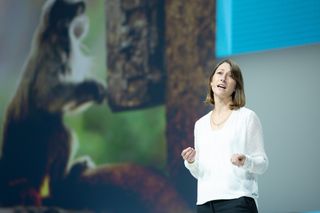London's Zoological Society fights species extinction with Google Cloud
Machine learning on Google Cloud Platform is helping to monitor and save wildlife around the world

The rainforest is a wonder of nature that's fundamental to the preservation of life on the planet, but in the last 40-years, the earth has lost 58% of its wildlife as biodiversity has reduced catastrophically across the world.
Hoping to reduce this horrific trend, the Zoological Society London (ZSL) has been working with Google Cloud, a partnership that has seen the cloud giant provide the hardware and software needed to monitor species around the world.
Speaking at Google Cloud Next, ZSL's conservation technology lead, Sophie Maxwell shed light on a project known as InstantWild, which the two companies first launched together in 2017.

ZSL's Sophie Maxwell on stage at Google Next 2018
In the beautiful southern Asian rainforests of Borneo, home to the orangutan, the giant elephant and the clouded leopard, ZSL and Google set up networks of camera traps to collect images of the diverse inhabitants who call it home.
Borneo is one of the oldest rainforests on the planet and these small digital cameras that are deployed in the field have a passive red sensor that detects motion and snaps a picture of wildlife as it walks past. They're typically deployed in grids of around 30 cameras, to survey wildlife populations in the areas ZSL work.

Male Orangutan photographed by camera traps in Borneo
Get the ITPro. daily newsletter
Receive our latest news, industry updates, featured resources and more. Sign up today to receive our FREE report on AI cyber crime & security - newly updated for 2024.
But technology can fail or be problematic, and in the case of camera traps, they take a large number of empty images and snaps of common species that happen to be walking past. This generates too much data.
"Currently, experts have to label images one by one which can take months," said Maxwell. "With over 100,000 images coming from each survey and only 5% of them containing the target species, this is really slowing us down.
"And these surveys are happening all over the world. It's like looking for a needle in a haystack and it's causing a bottleneck. We are wasting our time when we could be out there saving wildlife."
To tackle this challenge, ZSL used Google Cloud and machine learning to create its own image recognition models to help identify species in camera trap images for greater and faster insights.
"They tell us about the state of nature," said Maxwell. "Whether the population numbers are going up or whether they are going down, where species are going and what the threats are that they face. We urgently need this information to help us focus and also take conservation action and inform policy change.
"We created our own models without any machine learning expertise, using 35,000 expert labelled images, to create our own advanced model, which we applied to a challenging dataset from Borneo."

A Sun Bear photographed by a camera trap in Borneo
The models produced surprising results, with 91% classification accuracy for 34 species and according to Maxwell, auto machine learning sped up ZSL's conservation work from months to just days.
From this promising start, the wildlife conservation charity is hoping to further its work with Google Cloud and create a new platform powered by machine learning that will help conservationists create their own models for niche species and habitats.
This, Maxwell said, will be free and open source so that researchers around the world can share their models and refine them collectively as a community to process their camera track data to reveal new insights.
"Longer-term, we see machine learning playing a key role in giving real-time time view of the pulse of wildlife across the planet to speed up our conservation efforts, because time is running out," added Maxwell.
Images courtesy of ZSL
Bobby Hellard is ITPro's Reviews Editor and has worked on CloudPro and ChannelPro since 2018. In his time at ITPro, Bobby has covered stories for all the major technology companies, such as Apple, Microsoft, Amazon and Facebook, and regularly attends industry-leading events such as AWS Re:Invent and Google Cloud Next.
Bobby mainly covers hardware reviews, but you will also recognize him as the face of many of our video reviews of laptops and smartphones.





